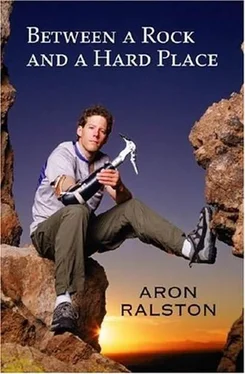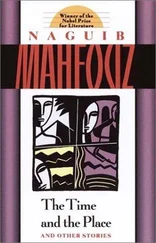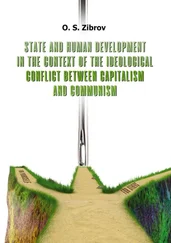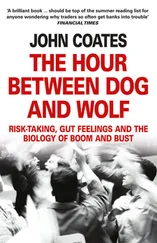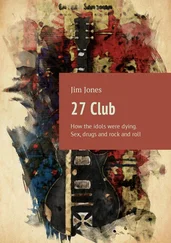I topped out on the moraine’s main drift, crawling as I’d done the day before, and hungrily eyed the clear dirt trail a half mile in the distance. The bear hadn’t relaxed his determination at all, continuing to follow me even within a distance of fifteen feet. Moving downhill off the moraine was faster going for me, and as the snowpack depth decreased, I picked up my pace. Twenty minutes later, at the edge of the snowpack, I stopped and waited for the bear to come closer. He had lagged relatively farther back, with thirty feet separating us, on the downhill section. Within ten seconds, he was within striking distance of my tiring arm-a meager fifteen feet-so I threw the first rock at his head and missed high, but the second one struck home behind the bear’s neck on his left side. He yelped and sped off to the closest tree. This time I changed the pattern of our maneuvers and followed him to the base of the tree and removed my packs. There were plenty of rocks around, and I proceeded to unleash my vengeance by pounding the bear’s rump-at least every third attempt-with baseball-sized stones. I shouted and yelled in anger at the bear, finding release from the strain and terror he’d put me through over the last twenty-four hours. After he climbed so high in the tree that I missed on five consecutive throws, I knelt and put my packs on again and strode back to the muddy trail and on toward my car, not looking back anymore.
I was done with Wyoming and rain and post-holing, and most of all, I was done with bears. The prospect of continuing on my planned trip to Glacier National Park-home to even more bears than the Tetons and Yellowstone and, due to its higher latitude, more snow than I had already encountered-was totally unappealing. I stopped at the ranger station to alert the park staff of my experience. The rangers told me they had heard of this kind of stalking behavior from other national parks (probably Glacier, I thought, putting the final nail in that coffin), but mine was the first report from the Tetons. They also told me that if you were to shout at a bear, wave your arms, stomp aggressively toward it, and then hit it with rocks, nine times out of ten you could count on being mauled. Score one for my guardian angel, I figured. I headed into town, where, after finding a motel room to dry my things out, and calling my parents to let them know what had happened and that I was coming home the next day, I went to several restaurants asking if I could get a bear flank steak, but there was none to be had. And, before going to bed, I did not go to see either of the two movies playing at the theater in Jackson- Jurassic Park 2 (dinosaurs stalk Jeff Goldblum) or The Edge (a bear stalks Anthony Hopkins).
The Night Shift
We know that the condemned man, at the end, does not resist but submits passively, almost gratefully, to the instruments of his executioner.
– EDWARD ABBEY, Desert Solitaire
IGLANCE AT MY WATCH; it’s 4:19 P.M. I have been trapped for an hour and a half, hammering my knife against the boulder for about half that time. There will be daylight until around nine P.M., but I already have my headlamp over my blue cap. Though it’s not on right now, I’m glad I brought the lamp on this day trip. As with my knife, I usually wouldn’t carry it on what should have been a short outing. That warning in Kelsey’s guidebook about checking for spiders and snakes was helpful, not because I’ve seen any creepy-crawlies, but because it suggested bringing a light. I’ve already used it to throw light up into the half-inch gap where my squashed wrist is caught, to further examine my hand from every angle.
One of the more important concerns I’ve been trying to address is how much of the boulder’s weight my wrist is supporting. If it’s holding barely any weight, the amount of rock I need to remove is less. The more the boulder is being propped up by my hand and wrist, the more it will settle as I remove weight-bearing material. In fact, for me to get my hand free in that case, the rock will have to settle completely onto the wall. Unfortunately, there’s a good probability that since there’s a gap between the stone and the north canyon wall immediately below and above my wrist, the boulder is not resting cleanly on the wall. The rock will settle; I’ll be working on a subtly moving target. I can only guess how much this will affect my chances of freeing my wrist, so I table the question and return to scraping and pecking at the boulder with my knife.
I try not to think about the fact that I am stuck. Though it’s an irrepressible reality, thinking about it doesn’t help my situation. Instead, I concentrate on finding small weaknesses in the face of the boulder just above and to the left of my trapped right wrist. My earlier instincts led me to etch a demarcation line above the softball-sized volume of rock that I have decided I must eradicate to gain my freedom. I’m speculating on a flaw in the rock’s structure, in a slight concavity that’s above the bulge almost six inches from my wrist; the demarcation line runs through this concavity. I start at my line, high on the face of the rock but a few inches below the top, and hack downward, attacking as near to my mark as I can manage. Tapping, then pounding, my multi-tool’s three-inch stainless-steel blade against the stone, I try to hit the same spot with each strike.
Everything else-the pain, the thoughts of rescue, the accident itself-recedes. I’m taking action. My mind seems determined to find and exploit any seams or natural cleavage of the chockstone to hasten the removal of material. Every few minutes, I pause to look over the boulder’s entire surface to make sure I’m not missing a more obvious target.
But the going is imperceptibly slow. I unfold the metal file from the tool, and for five minutes, I use it to etch the boulder. It works only marginally better than the knife, and only when I turn it on its side and saw down at the line. The rock is clearly more durable than the shallow rasps of the file. When I stop to clean the file, I see the grooves are filled with flecks of metal from the tool itself. I’m wearing down the edge without any effect on the chockstone. I inspect the boulder again, and noting the nonuniform coloring, its relative hardness compared to my knife and the walls, and its similarity to the chockstones of the gauntlet up above, I realize this boulder isn’t strictly sandstone. It seems to have come from the darker-colored layer within the Navajo sandstone that formed the overhanging lip a hundred yards upstream near the S-log at the head of this lower slot canyon, the one I’d hung from before dropping irreversibly into the sand about two hours ago.
“That’s bad news, Aron,” I think. “The rock layer formed that ledge because it’s more erosion-resistant than the rest of this canyon. This chockstone is the hardest thing here.” I wonder if it wouldn’t be faster to carve out the wall instead of the boulder, and decide to give that a try. Switching from the file back to the three-inch blade, I strike the multi-tool against the wall above my right wrist. The knife skitters across the pink sloping canyonside. Very close to stabbing myself in the arm at every blow, I conclude the geometry is prohibitive-I can’t slash at the wall in the right spot because my arm is in the way.
I pause to rest my left arm and hand and brush a little pulverized grit from my right forearm. I can’t see any change in the boulder’s position. I return to hacking at my target line in the concavity. Tick, tick, tick…tick, tick, tick. The sound of my knife tapping at the rock is pathetically minute, but all the same, it resounds through the canyon. I can strike the rock only so hard, otherwise my knife skitters off and I bash my knuckles, or I miss my target. I’m hoping to loosen the crystals around a gray knob in the chockstone and remove a quarter-sized chip in one piece. It will be an uplifting and measurable gain, but even the tiny bulge seems to be an impregnable safe. No matter what I try, I can’t crack it.
Читать дальше
